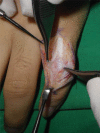Small Finger Snapping due to Retinacular Ligament Injury at the Level of Proximal Interphalangeal Joint: A Case Report
- PMID: 26091481
- PMCID: PMC4616564
- DOI: 10.1097/MD.0000000000000996
Small Finger Snapping due to Retinacular Ligament Injury at the Level of Proximal Interphalangeal Joint: A Case Report
Abstract
Pathological snapping secondary to posttraumatic subluxation of the extensor tendon at proximal interphalangeal joint (PIPJ) of the finger is rare. Here, we want to describe a patient with snapping of the left small finger at PIPJ due to retinacular ligament injury. A 24-year-old man was admitted because of a 5-year history of a snapping sound in the left small finger. On examination, the radial side lateral band of the small finger was dislocated volarly at the level PIPJ with flexion of >50°, which was clearly felt over the skin. There was an obvious snapping sound at the time of dislocation. There was no specific radiographic abnormality. With the patient under regional anesthesia, exploration through a zigzag skin incision over the dorsum of the PIPJ revealed that the retinacular ligament complex was injured. We also found a partial tear in PIPJ capsule, through the incision of the injured retinacular ligament complex. We repaired the joint capsule and retinacular ligament complex with prolene 4-0. Postoperatively the small finger was immobilized in a below-elbow plaster splint with full extension of the fingers for 1 week, then dynamic splinting was advised for another 5 weeks and unrestricted full active motion was allowed at the 6th week. At the 6-month follow-up, the patient had regained full range of motion with no discomfort, and there was no sign of recurrence. We stress that when there is snapping over the dorsum of the PIPJ of the finger, the clinician should suspect rupture of the retinacular ligaments, especially in minor trauma patients. Primary repair of retinacular ligaments and dynamic splinting provided satisfactory results without recurrence in our patient.
Conflict of interest statement
The authors have no funding and conflicts of interest to disclose.
Figures





References
-
- Inoue G, Tamura Y. Dislocation of the extensor tendons over the metacarpophalangeal joints. J Hand Surg Am 1996; 21:464–469. - PubMed
-
- Watson HK, Weinzweig J, Guidera PM. Sagittal band reconstruction. J Hand Surg Am 1997; 22:452–456. - PubMed
-
- Ikeda K, Matsuda M, Tomita K. Snapping of the proximal interphalangeal joint due to the lateral band. Arch Orthop Trauma Surg 2000; 120:531–532. - PubMed
-
- Harris C, Jr, Rutledge GL., Jr The functional anatomy of the extensor mechanism of the finger. J Bone Joint Surg Am 1972; 54:713–726. - PubMed
-
- Schweitzer TP, Rayan GM. The terminal tendon of the digital extensor mechanism: part 1, anatomic study. J Hand Surg Am 2004; 29:898–902. - PubMed
Publication types
MeSH terms
LinkOut - more resources
Full Text Sources

